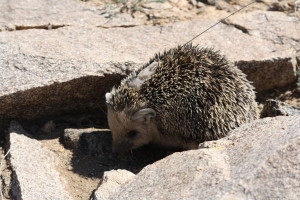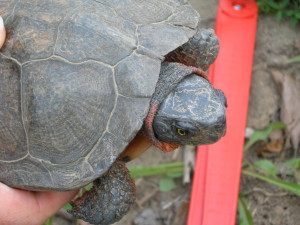As I have mentioned before, habitat fragmentation is one of the primary issues facing species around the world today- while it is far too big a topic to tackle in its entirety during one month’s posts, I think that investigating a few of its manifestations is manageable. I also think it’s necessary, since we have degrees of control over some causes of fragmentation and options that species have for responding to these changes in their habitat. I want to keep this discussion focused on small-scale, local habitat fragmentation- things like roads and fields and dams- because we can see these all around us, but we may not be thinking about their larger effects on the ecosystems around us.

Hedgehogs are used to dealing with a variety of ground surfaces, but they seem to move more quickly when they encounter artificial surfaces like asphalt
So let’s start with deliberate construction, the things we intentionally build. Roads are certainly one of the biggest barriers to animal movement, and there are a few reasons for this. For some animals, the physical road itself is undesirable habitat, especially when constructed from asphalt; hedgehogs in the UK, for example, were found to use a different type of running locomotion when sprinting across roads than when moving quickly through vegetation (Rondinini & Doncaster 2002), and they largely avoided crossing roads when possible. For other animals, there appears to be a psychological reluctance to approach roads, either because it means exposure to predators or because it means nearing human activity. When several bird species in Scotland were lured toward gaps between forest fragments using bird calls, goldcrests were largely unwilling to venture into open areas, possibly because their smaller wings and slower flight made them more vulnerable to predation (Creegan & Osborne 2005).Likewise, reindeer in Norway stayed several kilometers away from roads, power lines, and an associated tourist resort even though that meant loss of better foraging habitat (Vistnes & Nellemann 2001)- since this behavior was particularly marked in females during calving, this could lead to both overgrazing of used habitat and reduced survival of females and young. And then there is the most readily seen impact of roads: mortality. When looking at painted turtle populations in southern NH, Marchand (2002) found that ponds with many nearby roads had more adult and male turtles- females have to leave the ponds to find suitable nesting sites, leaving them vulnerable to traffic if they have to cross roads, and, if they are reluctant to cross, instead nesting closer to other females than they would normally, the eggs and juveniles are more likely to be found and eaten by predators- it’s kind of a no-win situation.

He was not a happy camper about being measured, and he’s probably a bit grumpy about being stuck above the dam
And let’s remember that we don’t just alter terrestrial systems. When I was working with wood turtles in southern NH, we found two very old, rather cranky males along the Ashuelot River in Surry- we estimated their age to be around 70 (which is pretty fantastic!)- unfortunately, we found no females in the area and no younger males. Although we knew of other sections of the river with wood turtle populations down river, the prognosis for these guys ever finding a mate was pretty grim because of a dam directly downstream from them (since the dam was built in 1941, these guys would have been just a few years old when construction stranded them upsteam). Even when access points are provided in dams and bridges, it may still prevent adequate movement between areas- brook charr densities in Quebec were much higher below highway crossings than above them (Pepino et al. 2012), and culverts placed over road crossings in Michigan channeled stream flow so much that crayfish had difficulty moving through them (Foster & Keller 2011). Why should we care about this? Well, to start with, as of 2011, the United States had 4,094,447 miles of roads (www.fhwa.dot.gov/policyinformation/statistics/2011). Between 1937 and 1999, road density in northern Wisconsin increased by more than 100% (Hawbaker et al. 2006)- imagine being a longer-lived animal in this landscape: the world you know is continuously more fragmented. Reduced movement between areas means reduced genetic variation which can lead to decreased resistance to further changes and threats- bobcat populations bordering roads in southern California showed lowered genetic diversity (Ruell et al. 2012). It also means that, if some event causes one population to disappear, the odds that the area will be recolonized by members of another population are low- ground beetles in Switzerland did not move between areas on either side of a road (Keller & Largiader 2003); this is very small-scale, and yet incredibly powerful, isolation.
The structures we create to facilitate trade, generate energy, control water flow, etc. have immediate impacts on the ecosystems that surround them. By disrupting movement of animals between locations, we can trap populations, reduce genetic diversity, and effectively sentence groups to extirpation. And there are definitely ways that we fragment species without turning soil into asphalt or building a wall too high to scale- for my next post, I’ll look at other types of small-scale fragmentation, including indirect effects of our lifestyles.
Works cited:
Creegan, H.P. and P.E. Osborne. 2005. Gap-crossing decisions of woodland songbirds in Scotland: and experimental approach. Journal of Applied Ecology 42: 678-687.
Foster, H.R. and T.A. Keller. 2011. Flow in culverts as a potential mechanism of stream fragmentation for native and nonindigenous crayfish species. Journal of the North American Benthological Society 30: 1129-1137.
Hawbaker, T.J., Radeloff, V.C., Clayton, M.K., Hammer, R.B. and C.E. Gonzalez-Abraham. 2006. Road development, housing growth, and landscape fragmentation in northern Wisconsin: 1937-1999. Ecological Applications 16: 1222-1237.
Keller, I. and C.R. Largiader. 2003. Recent habitat fragmentation caused by major roads leads to reduction of gene flow and loss of genetic variability in ground beetles. Proceedings: Biological Sciences 270: 417-423.
Marchand, M.N. 2002. Effects of landscape composition on rates of nest predation and population structure of painted turtles in southeastern New Hampshire. M.S. thesis, University of New Hampshire, Durham.
Pepino, M., Rodriguez, M.A. and P. Magnan. 2012. Impacts of highway crossings on density of brook charr in streams. Journal of Applied Ecology 49: 395-403.
Rondinini, C. and C.P. Doncaster. 2002. Roads as barriers to movement for hedgehogs. Functional Ecology 16: 504-509.
Ruell, E.W., Riley, S.P.D., Douglas, M.R., Antolin, M.F., Pollinger, J.R., Tracey, J.A., Lyren, L.M., Boydston, E.E., Fisher, R.N. and K.R. Crooks. 2012. Urban habitat fragmentation and genetic population structure of bobcats in coastal southern California. American Midland Naturalist 168: 265-280.
Vistnes, I. and C. Nellemann. 2001. Avoidance of cabins, roads, and power lines by reindeer during calving. The Journal of Wildlife Management 65: 915-925.
